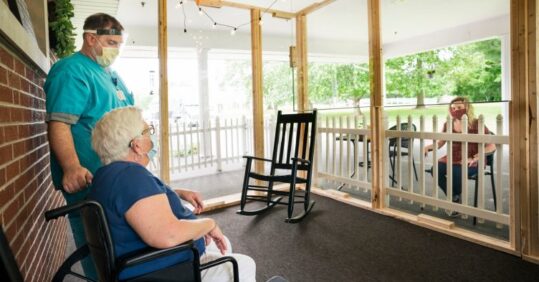No limits on care home visitors as restrictions ease

Limits on the numbers of visitors to care homes in England will be lifted today as part of the easing of restrictions laid out by the Government
From today, self-isolation periods will move in line with national requirements – down from 14 to 10 days for residents who test positive, or five full days if they test negative on day five and six. Care homes will also only have to follow outbreak management rules for 14 days, not 28.
In addition, by 16 February, care workers will be asked to take lateral flow tests before their shifts, replacing the current system of weekly PCR tests. And isolation periods for residents following emergency hospital visits will be reduced from 14 to a maximum of ten days.
Related Article: Funded nurse workforce plan needed for neighbourhood health services
It comes after tough restrictions throughout the Covid-19 pandemic– such as limiting the number of visitors – which many residents’ families and social care staff said turned ‘care homes into a prison’.
George Coxon, a care home owner based in Devon, told Nursing in Practice the recent relaxation of restrictions ‘will not make so much difference’ to his care homes because they will continue to be ‘careful’ and carry out risk assessments depending on each context.
He explained: ‘For example, if we let families visit with all their children, families will of course want to do that. But that is a higher risk of spreading infection, which could impact other residents.’
However, Mr Coxon pinpointed the reduction to self-isolation as a welcome change: ‘Last January, the horror was as much to do with the isolation as anything else. It meant residents were bunkered in their bedrooms, while many staff were self-isolating and visitors were restricted.’
Since December, under the Government’s Plan B measures, care home residents have only been allowed three name visitors and an essential care giver.
Related Article: Nurse had to ‘freeze’ PPE during pandemic to re-use in care home, Covid inquiry hears
The Government said the changes come after recent data has revealed that 86.5% of all care home residents in England had received their booster dose.
Sajid Javid, health and social care secretary, said: ‘Thanks to the progress we have made, I am delighted that care home restrictions can now be eased further allowing residents to see more of their loved ones.’
Gillian Keegan, minister for care, added: ‘The changes announced today are backed by scientists, ensuring we all have more freedoms from coronavirus, including care home residents and their families.’
The Government said updated guidance will be published ‘in due course’ with further details on changes to visiting, isolation and testing.
Related Article: More nursing apprenticeships and changes to student travel expenses
The headline rule changes
• Self-isolation periods reduced from 14 to 10 days for those who test positive, with further reductions if they test negative on days 5 and 6
• Isolation periods for those in care following an emergency hospital visit will be reduced from 14 to a maximum 10 days, in line with the NHS and following the latest advice from the Scientific Advisory Group for Emergencies (SAGE)
• Removing testing or self-isolation requirements following normal visits out

See how our symptom tool can help you make better sense of patient presentations
Click here to search a symptom




